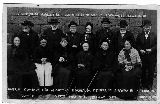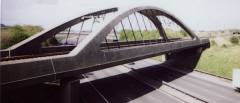A Brief History of Frodsham
- Early History
- 1600 to 1799
- 1800 to 1849
- 1850 to 1899
- 1900 to 1949
- 1950 to 1999
- 2000 onwards
- Sources and Further Information
Early History
Helsby Hill (123 metres) and Frodsham Hill are clear landmarks on the Cheshire plain. There are traces of Stone Age and Iron Age settlements on the hills of the area but the first known settlers in what is now Frodsham were Anglo-Saxons of the kingdom of Mercia. One possible origin of the name Frodsham is the Ham (a small village) established by Frod (or Froda), the leader of this group of Saxons. Another possible origin is the Ham on the Ford (over the local river, the Weaver).
Helsby was first settled by the Vikings who, in the tenth century AD, settled in the Wirral as far as Helsby or Hjallr-by (the village on the edge).
Both Frodsham and Macclesfield were owned by the Earl of Mercia before the Norman conquest. Both were valued at £8 in the Domesday survey: amongst the largest sums in Cheshire.
Frodsham was granted a charter by Ranulph de Blunville, Earl of Chester, in the 13th century. The charter gave it the right of self-administration. It sets out the rights of the burgesses, the citizens of the town. They were entitled to rent burgage plots of land in the town, they could use the common pasture and they were exempt from tolls in other places owned by their lord. Burgesses still had to use their lord’s mills and ovens for grinding corn and baking bread.
In 1283 Frodsham had 110 burgages. According to the Cheshire County Council leaflet Historic Towns in Cheshire, Frodsham is regarded as the best surviving example of a planned medieval town in Cheshire with burgage plots lining the north side of Main Street and on Church Street.
1600 to 1799
- 1654
- Frodsham Castle destroyed by fire
- 1661
- A grant by letters patent from Charles II for a market to be held on Thursday each week
- 1750
- Daniel Ashley buys the Castle ruins and builds Park Place on the site
1800 to 1849
- 1801
- Frodsham Population about 1,250
- 1814
- Methodist Victoria Hall opened on Fluin Lane (now a Carpet Warehouse)
- 1823
- Trinity Wesleyan Chapel opens on Chapel Lane (see 1873)
- 1836–1851
- The tithe maps were constructed.
- 1837
- The Rock Wesleyan Chapel opens (closed 1937, now Frodsham Library)
1850 to 1899
- 1850
- The railway arrives in Frodsham
- Construction of the sandstone bridge over the River Weaver, replacing the nearby brick bridge damaged during the Civil War
- 1851
- Opening of St John the Evangelist, Kingsley
- Frodsham Population about 2,179
- 1853
- Wesleyan Chapel, Helsby, opened
- 1859
- Eden Chapel built on Bradley Lane (closed 1994)
- 1870
- Consecration of St Paul’s Church, Helsby
- 1871
- Wesleyan Chapel, Kingsley, opens
- 1873
- The rebuilt Trinity Wesleyan Chapel opens on Main Street on November 6th. It was redeveloped in the late
1900s and closed in 2000.

- 1877
- Bourne Methodist Chapel opens (closed in 1987)
- 1880
- Restoration of St Laurence Parish Church started.

- St Dunstan’s Church opened temporarily on Main Street (the St Dunstan’s building is now Main Street Community Church)
- 1882
- Restoration of St Laurence Parish Church completed, first service 30 November.
- 1885
- Overton Five Crosses Wesleyan Chapel opens.
- 1886
- Union Chapel, Bridge Lane, designed by John Douglas, built.
- Kingsley Hall Children’s Home opens.
- 1894
- Frodsham becomes part of Runcorn Rural District.
- Manchester Ship Canal opened.
- 1896
- Kingsley Hall Children’s Home closes.
- 1899
- Parish Hall built
1900 to 1949
- 1901
- Liverpool Sanatorium, Kingswood opens.
- Territorial Drill Hall built on Main Street.
- Frodsham Population about 2,728.
- 1903
- Newton Hall branch of the NCH (National Children’s Home) opens in Frodsham.
- 1905
- Crossley Hospital (Manchester Sanatorium, Delamere) opens.
- 1908
- J H Cross photographed the oldest people in Frodsham

- The helter-skelter built on Frodsham Hill
- 1912
- Ship Street sewer laid
- 1912/1915
- Union Chapel, Bridge Lane, extended
- 1921
- War memorial on Frodsham Hill completed in June, still visible from most of Frodsham
- 1925
- Visit of King George V on 8th July
- 1928
- Frodsham Library opened
- 1932
- Castle Park given to the District Council
- 1949
- St Luke’s Catholic Church in Frodsham founded (in the building on Ship Street now used as the postal sorting office)
1950 to 1999
- 1951
- Frodsham Newton Hall Methodist Chapel opens (closed 1983)
- 1951
- Frodsham Population about 5,245
- 1958
- Church Street Railway Bridge replaced
- 1971
- M56 opens. The illustrations here are of the railway bridge over the M56 near Sutton Weaver. This bridge
used to referred to in the list of interesting projects of Ribblesdale Cement.


- 1974
- Frodsham becomes part of the new Vale Royal Council
- 1978
- New Frodsham Fire Station built.
- 1981
 St Luke’s church built on High Street site
St Luke’s church built on High Street site- 1985
- Newton Hall branch of the NCH (National Children’s Home) closes
- 1987
- Bourne Chapel closes and is converted to use as offices
- 1992
- In July, Frodsham became a town with a mayor
2000 onwards
- 2000
- Frodsham Methodist Trinity church closes. The site was redeveloped for housing, though the spire remains.

- 2005
- Djibril Cissé, at the time a Liverpool and France footballer, became Lord of the Manor of Frodsham. The title was recorded in the Domesday book.
- 2006
- Union Church closes after almost 120 years.
- Frodsham Hill Wood purchased by The Woodland Trust.
- 2009
- Vale Royal District Council and Cheshire County Council abolished. Frodsham put into the newly-formed Cheshire West and Chester unitary authority.
Some Sources and Further Information
Frodsham and Helsby in The Archive Photographs Series. Compiled by the Frodsham and District Local History Group and published by Chalford in 1995. ISBN 0-7524-0161-0. 120 pages of photographs from the mid-eighteenth century onwards.
Bygone Frodsham and District by David Nield published by Cheshire Libraries and Museums in 1985. ISBN 0-904532-13-5. Covering 1850–1940 in 52 pages (roughly A4 size landscape format) of photographs.
Historic Towns of Cheshire, published by Cheshire County Council, was fact sheet number 8 in their >Revealing Cheshire’s Past series.
Helsby Hill is partly in the care of the National Trust. It is listed and graded at www.megalithic.co.uk. It is also in the Wikipedia list List_of_Scheduled_Monuments_in_Cheshire_dated_to_before_1066
The Frodsham and District History Society. As well as the Frodsham and Helsby book cited above, the Society has published many other books and pamphlets and holds regular meetings. The society is also developing an image archive with thousands of images of Frodsham and district
.